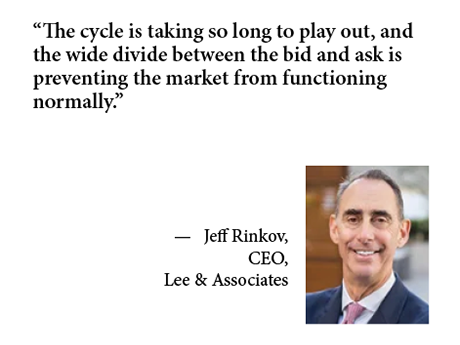Would-be commercial real estate investors and sellers for the last several months have been waiting for a sign that the Federal Reserve has tamed inflation, therefore giving the central bank reason to officially end its tightening program. October’s better-than-expected consumer price index increase of 3.2 percent — versus the 3.3 percent consensus — may have delivered that signal.
The futures markets immediately reduced the probability of a Fed interest rate hike in December to zero, with many capital markets analysts suggesting that it would begin to cut rates midway through 2024. But just an end to rate hikes could fuel investment sales activity, says Jeff Rinkov, CEO of Lee & Associates Commercial Real Estate Services.
“Once investors see some positive sentiment from the Fed, I think they’ll start to get interested in deploying what we believe is an enormous amount of capital that has been waiting on the sidelines,” he explains. “I also think that’s when investors will be met by more accommodating sellers. At the moment, price discovery continues to be very challenging and is driving a sluggish transaction environment.”
Crashing Sales
Indeed, investment sales volume through three quarters of 2023 totaled $276.3 billion, a year-over-year decline of 55 percent, according to MSCI Real Assets, a New York-based research firm that tracks commercial real estate deals of $2.5 million and up. Apartment transactions plunged the most — 64 percent — while office deals collapsed 62 percent.
Meanwhile, capitalization rates have increased between 50 and 70 basis points for most property categories over the period, MCSI Real Assets reported. While that indicates some pricing adjustment has occurred, a stubborn bid-ask spread persists, Rinkov says. Plus, except for hotels at 8.5 percent, cap rates are still below or roughly even with mortgage rates of between 6.8 percent and 8 percent.
“There is definitely a recognition of a new normal in the investment world that has taken hold,” he adds. “But I don’t know if sellers have moved as far on pricing as buyers would like to see them go. Many property owners who secured debt on their properties more than 12 months ago are generating great cash flow, which is allowing them to wait for interest rates to normalize.”
Still, even before the government reported the improved inflation numbers, Rinkov had seen an uptick in the amount of property coming to market. Fourth quarters have traditionally been the most active commercial real estate transaction period as investors and sellers try to wrap up deals before the end of the year.
“Our agents across North America are experiencing greater activity, and I think investors are growing properly impatient,” he explains. “I believe that will lead us into a strong 2024, with the back half of next year gaining even more strength.”
Looking Ahead
On a relative basis, capital continues to flow into the Sunbelt States, Rinkov observes, and he anticipates that distressed office assets will begin to trade with more frequency as investors seek to buy the properties below replacement cost.
In other sectors, investors are likely to approach multifamily and industrial deals more cautiously, especially in markets where new construction could increase short-term vacancy and drive rent moderation. In acknowledgment of changing apartment conditions, the Federal Housing Finance Committee recently reduced the 2024 multifamily loan purchase caps of Fannie Mae and Freddie Mac to $70 billion each from $75 billion in 2023.
Meanwhile, in the industrial hotspots of northern New Jersey and the Inland Empire in California, rental rates spiked largely on the back of surging online sales during the pandemic. But those assets could see a rent retreat by as much as 25 percent, Rinkov suggests.
“You have had distribution and third-party logistics companies taking on space as if the trajectory of internet sales in 2021 was going to continue,” he says. “E-commerce growth is still very strong, but not at the rate of what we saw during COVID. We’re already starting to see a rollback in rents.”
Stubborn Cycle
As the end of 2023 approaches, some commercial real estate investors may still be hoping for an economic slowdown that was supposed to have arrived by now, Rinkov reveals. But recession predictions have continually been pushed farther into the future or abandoned altogether amid the historically low unemployment rate of less than 4 percent. The resumption of student loan payments could dent spending, he adds, but so far consumers have remained resilient.
“The cycle is taking so long to play out, and the wide divide between the bid and ask is preventing the market from functioning normally,” Rinkov observes. “Some investors have been waiting for a recession with the idea that sale transaction volumes would start to recover amid diminished costs of capital and debt, but we just can’t seem to get there.”
— By Joe Gose. Lee & Associates is a content partner of REBusinessOnline. To learn more about Lee & Associates, click here.


